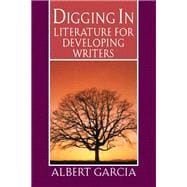
Note: Supplemental materials are not guaranteed with Rental or Used book purchases.
Purchase Benefits
What is included with this book?
| (Note:Each chapter concludes with an Ideas for Writing list.) | |
| Reading Literature: A Brief Introduction | |
| Family History | |
| Birthday Poem | |
| A Photo of Immigrants, 1903 | |
| Picture Bride | |
| Powder | |
| My Father's Song | |
| Father | |
| Nikki-Rosa | |
| Not Skin Deep—Heart Deep | |
| Driving Lessons | |
| Catfish in the Bathtub | |
| Growing Up/Growing Old | |
| My Oedipus Complex | |
| A Song in the Front Yard | |
| Eleven | |
| Death of the Right Fielder | |
| Rite of Passage | |
| The Chase | |
| Junk Mail | |
| The Woman Who Makes Swell Doughnuts | |
| Henry Manley, Living Alone, Keeps Time | |
| Pricing | |
| Learning and Teaching | |
| You Go to School to Learn | |
| Yuba City School | |
| Books | |
| The Sanctuary of School | |
| Lynda Barry | |
| Office Hour | |
| The Struggle to Be an American Girl | |
| Manners | |
| Miss Hicks | |
| Advice I Wish Someone Had Given Me | |
| The Lesson | |
| The Emotional Side | |
| Marks,Linda Pastan | |
| Homage to My Hips | |
| Daddy Tucked the Blanket | |
| Leslie in California | |
| Oranges | |
| Paper Pills | |
| Winter Love | |
| It's Over | |
| Loyal | |
| Two on Two | |
| Work and Dreams | |
| What Work Is | |
| Work | |
| The Witness | |
| The Case Against Chores | |
| The Circuit | |
| Cannery Town in August | |
| The Fisherwoman | |
| $100 and Nothing! | |
| The Men We Carry in Our Minds | |
| To Work | |
| Issues/Positions | |
| Say Yes | |
| Beginning | |
| The Eye of the Beholder | |
| The Immigrants | |
| Mother Tongue | |
| Videotape | |
| The Swimming Pool | |
| Richard Cory | |
| Ethics | |
| Traveling Through the Dark | |
| Popular Mechanics | |
| Glossary | |
| Author and Title Index | |
| Table of Contents provided by Publisher. All Rights Reserved. |
The New copy of this book will include any supplemental materials advertised. Please check the title of the book to determine if it should include any access cards, study guides, lab manuals, CDs, etc.
The Used, Rental and eBook copies of this book are not guaranteed to include any supplemental materials. Typically, only the book itself is included. This is true even if the title states it includes any access cards, study guides, lab manuals, CDs, etc.